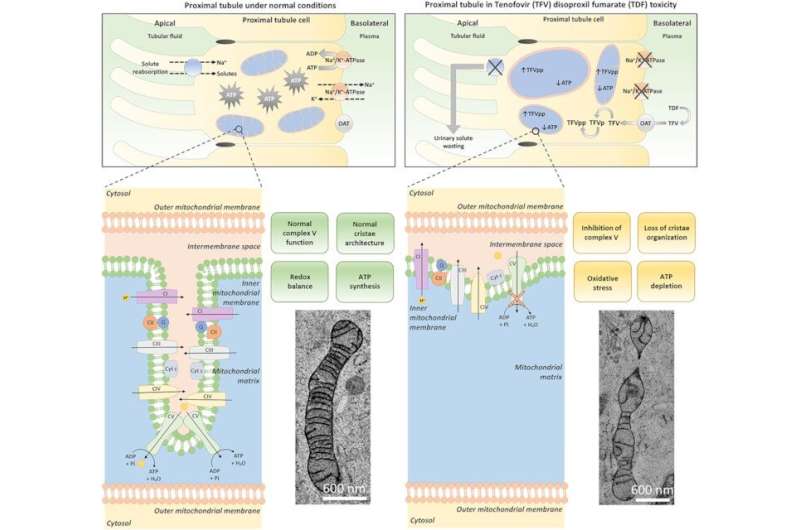This article has been reviewed according to Science X's editorial process and policies. Editors have highlighted the following attributes while ensuring the content's credibility:
fact-checked
trusted source
proofread
Researchers identify how HIV/hepatitis drug harms the kidneys

A first-of-its-kind study identifies mechanisms that explain how a drug commonly used to treat HIV and hepatitis causes kidney disease and kidney injury. The study is published ahead of print in Function.
Drug toxicity—harmful effects from medications that harm the body's organs—is a common cause of kidney disease and causes an estimated 25% of diagnosed cases of acute kidney injury. Kidney toxicity is also a frequent reason for failure in new drug development. Mitochondrial function—function of the cells' energy centers—is often affected in cases of drug toxicity, but it's not clear how or why this happens.
Tenofovir disoproxil fumarate is a first-line treatment used worldwide for HIV and hepatitis B. The active ingredient, tenofovir, is known as a nephrotoxin (a drug that harms the kidneys). Researchers used a human-derived cell line that carries many of the same characteristics of the kidney's proximal tubule cells to explore the mechanisms that underlie this nephrotoxicity.
They exposed the cells to the drug for 24 hours and used new sophisticated imaging techniques and comprehensive metabolic screening to determine in detail how the cells reacted to the tenofovir. The researchers explained that they used doses of the drug that are higher than those that would normally be prescribed, however "[tenofovir disoproxil fumarate] toxicity in humans is a cumulative phenomenon, likely explained by accumulation of harmful metabolites within [proximal tubule] cells over time."
The research team found that in treated cells, a metabolite (a product created through the breakdown of the drug) of tenofovir led to a decrease in complex V activity and expression. Complex V is a protein complex in the mitochondria that converts energy from food that is consumed into a form the cells can use. A decrease in complex V levels was also observed in biopsy samples from humans with tenofovir-induced kidney disease. The drop in complex V activity points to why mitochondria malfunction occurs during cases of drug toxicity.
"By combining high-throughput imaging with detailed metabolic profiling, we were able to identify for the first time the mitochondrial phenotype of [tenofovir disoproxil fumarate] toxicity in renal epithelial cells. We envisage that this approach could be harnessed not only to investigate other drugs and toxins, but also for further purposes, such as uncovering novel genetic regulators of transport and metabolism in epithelia," the researchers wrote.
More information: Adam Pearson et al, Integration of High-Throughput Imaging and Multiparametric Metabolic Profiling Reveals a Mitochondrial Mechanism of Tenofovir Toxicity, Function (2022). DOI: 10.1093/function/zqac065




















